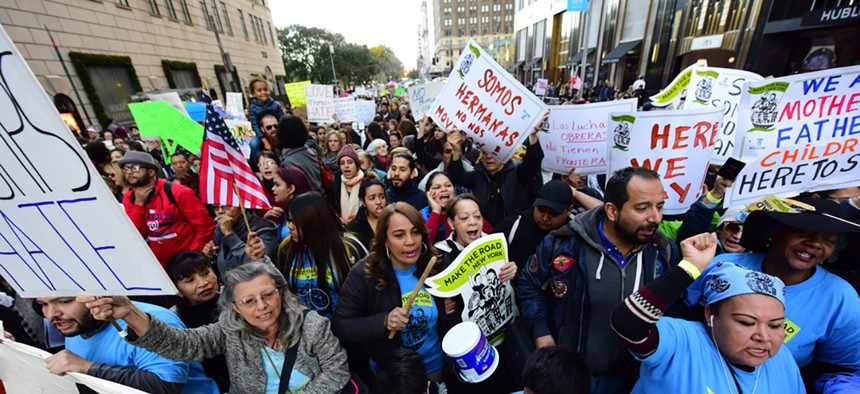
New Yorkers rally at a pro-immigration event in 2016. a katz / Shutterstock.com
These White House Policies Could Turn More Than One Million People Into Undocumented Immigrants
First Donald Trump targeted people in the country illegally. Now his administration is also going after those with permission to be in the country.
In his first year as US president, Donald Trump targeted people in the country illegally. Now his administration is also going after those with permission to be in the country.
In the next few weeks, three White House policies could essentially render hundreds of thousands of foreigners currently allowed to live and work in the US into undocumented immigrants subject to deportation. They are all aimed at ending programs that grant immigrants in unusual circumstances temporary permits to stay in the US. Their effects would not only have permanent implications for those affected, but for the US economy as well, immigrant advocates argue.
Here’s a look at each of the policies and who they target.
An end to DACA
The fate of participants in the Deferred Action for Childhood Arrivals program, or DACA, has been hanging since September, when Trump ended the Obama-era policy that protects undocumented immigrants who came to the US as children.
At that time, some 690,000 people were receiving DACA protection. Since then, some of those immigrants have lost their protections; the same will happen to the rest of them in March if Congress doesn’t pass a law to replace the program. Without DACA, those immigrants would become subject to deportation.
While Trump has accused Democrats in Congress of stalling efforts to find a solution for dreamers, as DACA recipients are often called, he seems to be unwilling to make any of the concessions to make a deal. On Thursday (Jan. 4,) he said he wouldn’t support any DACA alternative that didn’t also include funding for his proposed border wall between the US and Mexico, ending the visa lottery program and family-based immigration—conditions Democrats have said they wouldn’t accept.
“We’d love to take care of DACA, but we’re only going to do it under these conditions,” he said after a meeting with Republican Congress members on immigration.
Temporary protected status
The future of 195,000 El Salvadoran immigrants is also up in the air ahead of a Jan. 8 Department of Homeland Security decision. On that date, the agency is due to decide whether to extend or end temporary protected status, or TPS, for certain citizens of El Salvador who have been allowed to live and work in the US for nearly two decades.
The intent of the TPS program is to provide temporary refuge to catastrophe-stricken countries until conditions improve back home. The designation is initially granted for up to 18 months, but previous administrations have indefinitely extended it for some countries, including El Salvador. During that time, the program’s beneficiaries have made their lives in the US. Many have children who are US citizens.
Trump administration officials now say the program should only be used for short-term protection. So they are upping the scrutiny on TPS as country deadlines for renewal come up. In November, they ended TPS for 46,000 Haitians and 2,500 Nicaraguans.
El Salvadorans are by far the biggest category of TPS recipients; their roughly 193,000 US-born children make up a group almost as large. Their supporters argue that conditions in the small Central American country remain too dire for the immigrants to return. The TPS designation was spurred by a series of devastating earthquakes in 2001, but the country has been plagued by other problems since, including pervasive violence. The mayors of several of the US’s biggest cities are also lobbying DHS officials to let Salvadorans to stay, saying at this point they are deeply embedded in their communities and local economies.
H-1B extensions
The Trump administration is also considering ending an extension that allows certain H-1B visa holders to stay in the country, according to reports.
H-1B visas, which are issued to highly-specialized workers, are valid for up to six years. But they can be extended for longer periods for people who are applying for a green card or permanent residency. Immigrant advocates say this extension is necessary because of the long backlogs to complete that process. Because of country quotas, immigrants from places such as India and China have to wait in line for years in order to get a green card.
Those are the people the Trump administration is targeting with the proposed change. US Citizenship and Immigration Services does not publish statistics on this group, and did not respond to requests for comment. It’s not even clear how many H-1B workers there are in total—in 2013, the Economic Policy Institute calculated there were about 500,000.
Experts estimate anywhere from 100,000 to one million people could be affected if H-1B workers were no longer allowed to apply for extensions. The bulk of them, they say, would be from India. “It would remove hundreds of thousands of tech workers from the work force, and discourage new people from coming,” said Leon Fresco, an immigration lawyer and former deputy assistant attorney general at the Justice Department’s Office of Immigration Litigation.
The proposed policy is in line with Trump’s campaign to “Hire American,” and would address complaints among his supporters that foreigners are displacing American workers. But some analysts point out it also contradicts Trump’s stated goal of make immigration to the US merit-based.
By the time they can file for the H-1B extension, many immigrants have already gone through a stringent vetting process to certify that no American can do their job, and that they add value to the US economy, says Sarah Pierce, a policy analyst at the Migration Policy Institute. In other words, they are exactly the kind of immigrants Trump says he wants.






